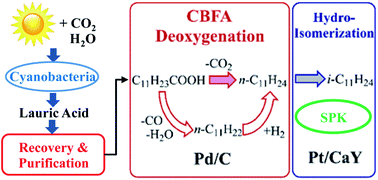当前位置:
X-MOL 学术
›
Sustain. Energy Fuels
›
论文详情
Our official English website, www.x-mol.net, welcomes your
feedback! (Note: you will need to create a separate account there.)
Catalytic conversion of cyanobacteria-derived fatty acids to alkanes for biorenewable synthetic paraffinic kerosene†
Sustainable Energy & Fuels ( IF 5.0 ) Pub Date : 2018-02-09 00:00:00 , DOI: 10.1039/c7se00558j Taylor C. Schulz 1, 2, 3, 4 , Mason Oelschlager 4, 5, 6, 7, 8 , Simon T. Thompson 1, 2, 3, 4 , Wim F. J. Vermaas 4, 7, 8, 9 , David R. Nielsen 4, 5, 6, 7, 8 , H. Henry Lamb 1, 2, 3, 4
Sustainable Energy & Fuels ( IF 5.0 ) Pub Date : 2018-02-09 00:00:00 , DOI: 10.1039/c7se00558j Taylor C. Schulz 1, 2, 3, 4 , Mason Oelschlager 4, 5, 6, 7, 8 , Simon T. Thompson 1, 2, 3, 4 , Wim F. J. Vermaas 4, 7, 8, 9 , David R. Nielsen 4, 5, 6, 7, 8 , H. Henry Lamb 1, 2, 3, 4
Affiliation

|
A two-step catalytic process for converting cyanobacteria-derived fatty acids (CBFAs) to linear and branched alkanes for biorenewable synthetic paraffinic kerosene was demonstrated. Fatty acids synthesized and secreted into the growth medium by an engineered strain of the cyanobacterium Synechocystis sp. PCC 6803 were recovered from 20 liter photobioreactor cultures by adsorption on hydrophobic resin beads. By design, lauric acid (LA, C12:0, ∼80% w/w) was the main CBFA constituent; however, myristic acid (MA, C14:0, 6–10% w/w), palmitic acid (PA, C16:0, 2–6% w/w), and β-hydroxymyristic acid (BHMA, 2–3% w/w) also were produced. LA and MA model compounds were deoxygenated over a 5 wt% Pd/C catalyst to n-undecane and n-tridecane, respectively, with high yields and CO2 selectivities. Major products of BHMA deoxygenation over Pd/C were n-tridecane and 2-tridecanone. BHMA concentrations typical of the CBFA samples were found to inhibit LA deoxygenation. Because Pd sites responsible for fatty acid decarboxylation are poisoned at sulfur concentrations [S] typical of crude CBFA samples (100–150 ppm), post-recovery purification procedures were developed and evaluated based on their efficacy in reducing S-containing impurities. Deoxygenation of CBFAs was most effective when purification procedures limited [S] to <15 ppm, as evidenced by >80% n-alkane yield and ∼90% CO2 selectivity. The n-alkane products of CBFA deoxygenation were hydroisomerized in the liquid phase (with added n-dodecane) over a 0.70 wt% Pt/CaY catalyst. The resultant mixtures had isoalkane/normal alkane ratios of 0.25–0.50.
中文翻译:

蓝细菌衍生的脂肪酸催化转化为烷烃,用于生物可再生的合成石蜡煤油†
演示了两步催化过程,可将蓝细菌衍生的脂肪酸(CBFA)转化为可生物再生的合成石蜡煤油的直链和支链烷烃。脂肪酸由蓝藻的工程菌株合成和分泌到生长培养基中集胞藻属。通过吸附在疏水性树脂珠上,从20升光生物反应器培养物中回收PCC 6803。根据设计,月桂酸(LA,C12:0,〜80%w / w)是CBFA的主要成分;但是,肉豆蔻酸(MA,C14:0,6–10%w / w),棕榈酸(PA,C16:0,2–6%w / w)和β-羟基肉豆蔻酸(BHMA,2–3% w / w)也被生产出来。将LA和MA模型化合物在5 wt%的Pd / C催化剂上脱氧为正十一烷和n-十三烷分别具有高产率和CO 2选择性。在Pd / C上BHMA脱氧的主要产物是正十三烷和2-三甲癸酮。发现典型的CBFA样品的BHMA浓度会抑制LA脱氧。由于负责脂肪酸脱羧的Pd位点在粗制CBFA样品的典型硫浓度[S](100-150 ppm)下被中毒,因此开发了回收后纯化程序,并根据其减少含S杂质的功效进行了评估。当纯化程序将[S]限制为<15 ppm时,CBFA的脱氧作用最为有效,这可通过> 80%的正烷烃收率和〜90%的CO 2选择性来证明。该ñ在0.70wt %的Pt / CaY催化剂上,将液相的CBFA脱氧α-烷烃产物加氢异构化(加入正十二烷)。所得混合物的异烷烃/正构烷烃比为0.25-0.50。
更新日期:2018-02-09
中文翻译:

蓝细菌衍生的脂肪酸催化转化为烷烃,用于生物可再生的合成石蜡煤油†
演示了两步催化过程,可将蓝细菌衍生的脂肪酸(CBFA)转化为可生物再生的合成石蜡煤油的直链和支链烷烃。脂肪酸由蓝藻的工程菌株合成和分泌到生长培养基中集胞藻属。通过吸附在疏水性树脂珠上,从20升光生物反应器培养物中回收PCC 6803。根据设计,月桂酸(LA,C12:0,〜80%w / w)是CBFA的主要成分;但是,肉豆蔻酸(MA,C14:0,6–10%w / w),棕榈酸(PA,C16:0,2–6%w / w)和β-羟基肉豆蔻酸(BHMA,2–3% w / w)也被生产出来。将LA和MA模型化合物在5 wt%的Pd / C催化剂上脱氧为正十一烷和n-十三烷分别具有高产率和CO 2选择性。在Pd / C上BHMA脱氧的主要产物是正十三烷和2-三甲癸酮。发现典型的CBFA样品的BHMA浓度会抑制LA脱氧。由于负责脂肪酸脱羧的Pd位点在粗制CBFA样品的典型硫浓度[S](100-150 ppm)下被中毒,因此开发了回收后纯化程序,并根据其减少含S杂质的功效进行了评估。当纯化程序将[S]限制为<15 ppm时,CBFA的脱氧作用最为有效,这可通过> 80%的正烷烃收率和〜90%的CO 2选择性来证明。该ñ在0.70wt %的Pt / CaY催化剂上,将液相的CBFA脱氧α-烷烃产物加氢异构化(加入正十二烷)。所得混合物的异烷烃/正构烷烃比为0.25-0.50。











































 京公网安备 11010802027423号
京公网安备 11010802027423号